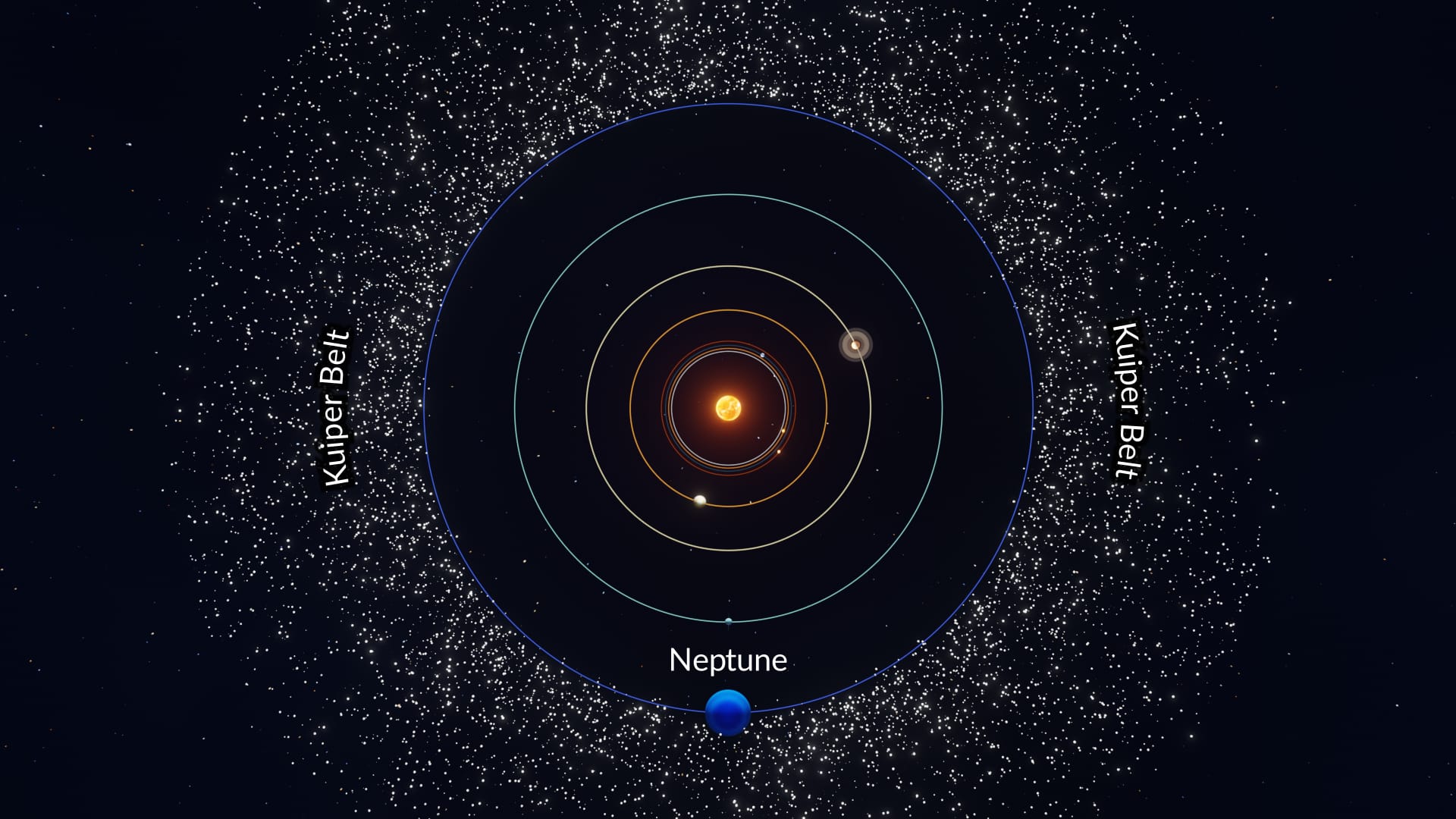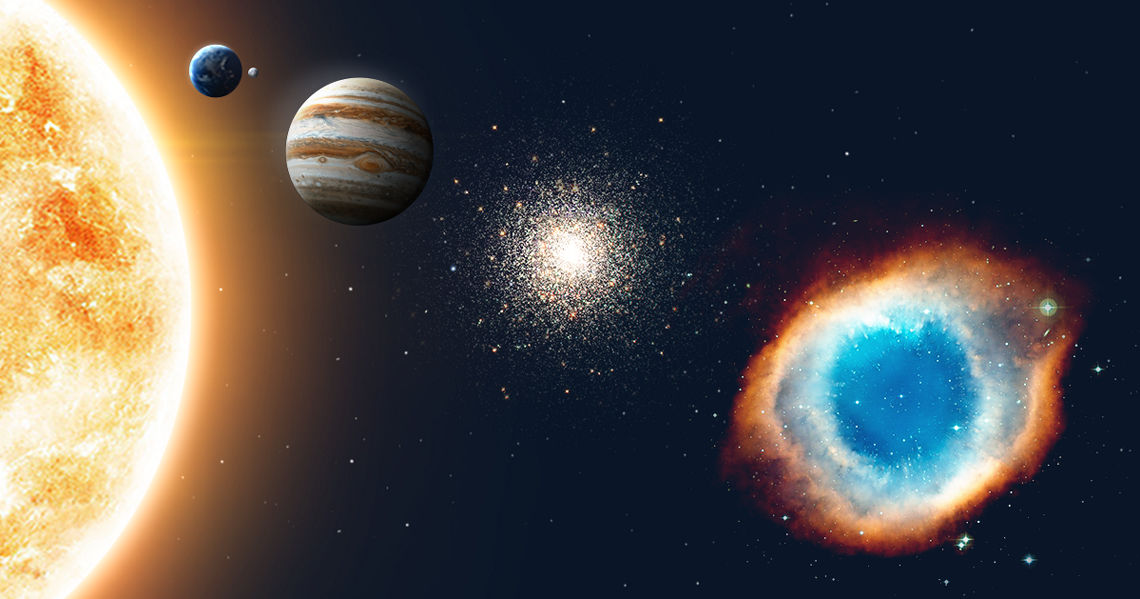Kuiper Belt: The Solar System’s Frontier
On December 7, 2025, we celebrate the 120th anniversary of the birth of Gerard Kuiper, the astronomer whose name the Kuiper Belt now bears. Ironically, Kuiper believed this region no longer existed — yet today it’s known as one of the most intriguing zones in the Solar System. Read about this distant area and the mysteries it may hide. Even though you can’t see Kuiper Belt objects with the naked eye, you can still track some of them, like Eris or Haumea — use the Sky Tonight app to instantly find out their current location in the sky.
Contents
- What is the Kuiper Belt?
- Who discovered the Kuiper Belt?
- How did the Kuiper Belt form?
- Kuiper Belt objects
- The Kuiper Belt and Planet Nine
- What spacecraft visited the Kuiper Belt?
- F.A.Q.
- What is the Kuiper Belt: to sum up
What is the Kuiper Belt?

The Kuiper Belt is a disk-shaped region of the Solar System located beyond Neptune’s orbit. It extends from about 30 to 55 astronomical units from the Sun. The Kuiper Belt contains millions of icy bodies believed to be leftovers from the formation of the Solar System. Despite the enormous size of the belt, the total mass of all the objects in it equals a few percent of the Earth’s mass (roughly 1-10%, according to current estimates).

Who discovered the Kuiper Belt?
The Kuiper Belt is sometimes called the Kuiper-Edgeworth Belt, after astronomers Gerard Kuiper and Kenneth Edgeworth. Neither of the two discovered this region, but both independently predicted its existence decades before it was observed.
The ideas about a disk of icy objects beyond Neptune date back to the first half of the 20th century. Since the discovery of Pluto in 1930, scientists have speculated that there might be other celestial bodies near it. In 1943, Irish astronomer Kenneth Edgeworth suggested that the outer region of the Solar System is occupied by a large number of comparatively small bodies. This was his only contribution to the discovery of the Kuiper Belt. Then, in 1951, Dutch astronomer Gerard Kuiper had a similar hypothesis about a belt of small objects beyond Neptune. But here’s a fun fact for you: Kuiper thought that the belt didn’t exist anymore. He believed that the gravitational influence of the outer planets (including Pluto) had scattered the objects in the belt to the Oort Cloud. So, ironically, Gerard Kuiper proposed the absence of the Kuiper Belt, not its existence.
Speculations about the hypothetical region continued for decades. Only in 1992, after five years of searching, astronomers David Jewitt and Jane Luu finally discovered the first object in the Kuiper Belt — 1992 QB1 (later named 15760 Albion). Six months later, they found the second object — 1993 FW. So maybe the region should have been named the Jewitt-Luu Belt? At least these two astronomers believed in the belt’s existence.
Why is the Kuiper Belt named after Gerard Kuiper?
The region is named after Gerard Kuiper not because he discovered it, but because his ideas helped shape how we think about the outer Solar System. Even though he believed that any icy bodies beyond Neptune had already been scattered away, his early insights set the stage for the later discovery of the Kuiper Belt. Beyond this theoretical work, Kuiper made many important contributions to planetary science. He discovered two moons (Miranda of Uranus and Nereid of Neptune), helped choose landing sites for NASA’s Moon landing missions, and played a key role in understanding what planets and their moons are made of and how they evolved. Thanks to these achievements, Kuiper is often referred to as the “father of modern planetary science.” With such a legacy, it’s no surprise that one of the most fascinating regions of our cosmic neighborhood now carries his name.
How did the Kuiper Belt form?
About 4.6 billion years ago, the Solar System formed from a cloud of gas and dust called the solar nebula. Most of the material from the nebula merged to form the Sun and the planets, while a part of it remained in the form of small celestial bodies.
The objects in the Kuiper Belt are such leftovers from the Solar System formation. Similar to the asteroid belt between Mars and Jupiter, the Kuiper Belt could have become a planet if not for the presence of another giant planet nearby. Neptune’s immense gravity stirred up the region so strongly that small chunks of rock and ice could no longer merge into a single planet-sized body.
Kuiper Belt objects
The celestial bodies inhabiting the Kuiper Belt are called Kuiper Belt objects (KBOs) or trans-Neptunian objects (TNOs). According to NASA, more than 2,000 KBOs are currently known to astronomers.
Unlike asteroids in the main asteroid belt that are composed primarily of rock, most KBOs are icy bodies composed of frozen methane, ammonia, and water. They can also exhibit a wide range of colors — from red to blue to white.
Astronomers divide Kuiper Belt objects into several groups: classical (with nearly circular orbits), resonant (trapped in orbital resonances with Neptune, like Pluto), and scattered objects with highly elongated orbits extending hundreds of AU.

KBOs range in size from large boulders to more than 2,300 km (1,400 miles) in diameter. The largest KBOs are four dwarf planets: Pluto (2,376 km or 1,476 miles), Eris (2,326 km or 1,445 miles), Makemake (1,430 km or 888 miles), and Haumea (1,632 km or 1,014 miles). The Kuiper Belt also contains several dwarf planet candidates — among them are Orcus, Quaoar, Gonggong, and Sedna.
The four dwarf planets, plus Gongong and Quaoar have moons orbiting around them. Haumea even has a ring! Also, the Kuiper Belt contains many binaries — two objects that orbit around the common center of mass. The most notable example of a binary KBO is the Pluto-Charon binary.
The Kuiper Belt is also thought to be a source of comets. Some existing Kuiper Belt objects can be gravitationally perturbed by Neptune and sent toward the Sun, where they become short-period comets. Unlike the Oort Cloud, where most long-period comets originate, the Kuiper Belt produces short-period comets, which take less than 200 years to orbit the Sun.
The Kuiper Belt and Planet Nine
Studying Kuiper Belt objects has led to a new, exciting hypothesis. Astronomers Konstantin Batygin and Mike Brown observed several KBOs and noticed a peculiar clustering of their orbits. In 2016, the scientists presented their theory: the objects’ unique orbits could be explained by the gravitational influence of an unknown planet located far beyond Pluto! The hypothetical Neptune-sized world was nicknamed Planet Nine. It could have a mass of five to ten times that of the Earth and an orbital period of about 10,000 Earth years. The mysterious planet has not been discovered yet, but astronomers do not give up and continue their search.
What spacecraft visited the Kuiper Belt?

The only space probe that has studied Kuiper Belt objects up close is NASA’s New Horizons. It was launched in 2006 and flew by Pluto in 2015. Then, on January 1, 2019, New Horizons approached another KBO called Arrokoth, which became the farthest object in the Solar System visited by a spacecraft. Currently, the mission’s team is trying to find a suitable object for New Horizons to perform one more flyby.

Unfortunately, there are no planned missions to the Kuiper Belt right now. Nevertheless, scientists have been considering the possibility of sending probes to other KBOs like Makemake and Haumea in the future.
F.A.Q.
What is the largest object in the Kuiper Belt?
The largest Kuiper Belt object is the dwarf planet Pluto, which has a diameter of 2,376 km (1,476 miles). It is followed by another dwarf planet, Eris, which is 2,326 km (or 1,445 miles) in diameter.
How many planets are in the Kuiper Belt?
Due to Neptune's gravitational influence, there are no planets in the Kuiper Belt. However, the belt contains four of the five officially recognized dwarf planets: Pluto, Eris, Makemake, and Haumea. The fifth dwarf planet — Ceres — is located in the asteroid belt between Mars and Jupiter.
How long would it take to reach the Kuiper Belt?
NASA’s New Horizons — the only spacecraft that has visited the Kuiper Belt — took nine and a half years to reach Pluto. The space probe was moving at a speed of 58,580 km/h (36,400 mph) and traveled a distance of about 5 billion km (3 billion miles). It should be noted that at the time of its launch in 2006, New Horizons was the fastest spacecraft ever built.
What is the difference between the Oort Cloud and the Kuiper Belt?
Like the Kuiper Belt, the Oort Cloud is believed to contain trillions of small icy objects based on theoretical models and comet statistics. Over billions of years, some scattered Kuiper Belt objects may have been ejected much farther from the Sun, populating the distant Oort Cloud. However, it is a much more distant region than the Kuiper Belt — it would take a spacecraft about 300 years to reach its inner boundary. Also, it is not a disk but a giant spherical shell that surrounds the whole Solar System, including the Kuiper Belt. The Oort Cloud might contain trillions of objects and is believed to be a source of most long-period comets.
What is the Kuiper Belt: to sum up
The Kuiper Belt is a vast ring of small icy bodies beyond Neptune’s orbit. It is home to Pluto and several other dwarf planets. Ironically, the Kuiper Belt was named after a person who predicted its absence. Studying Kuiper Belt objects not only led to the Planet Nine hypothesis but continues to reshape our understanding of how the outer Solar System formed. Upcoming observatories like the Vera Rubin Telescope may soon reveal thousands more hidden worlds. While astronomers search for new distant objects, you can explore the known ones yourself with Sky Tonight — a stargazing app that lets you find space objects in the sky above you.
